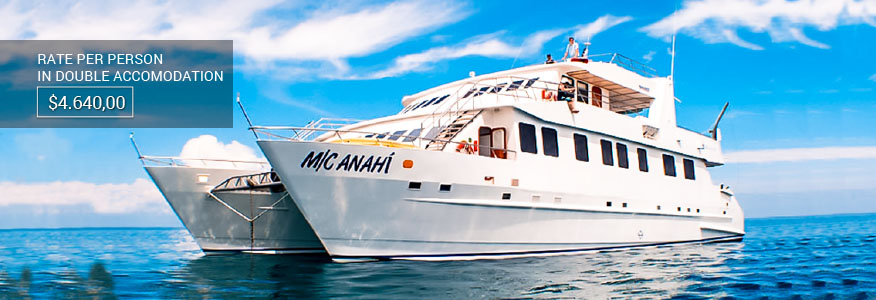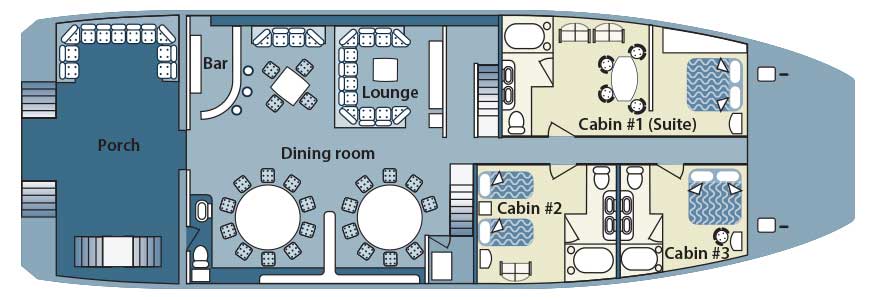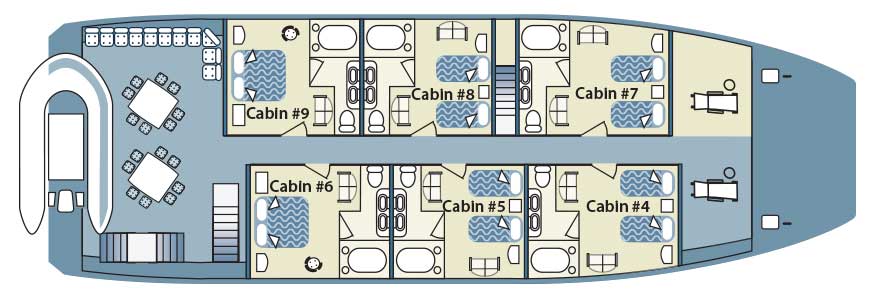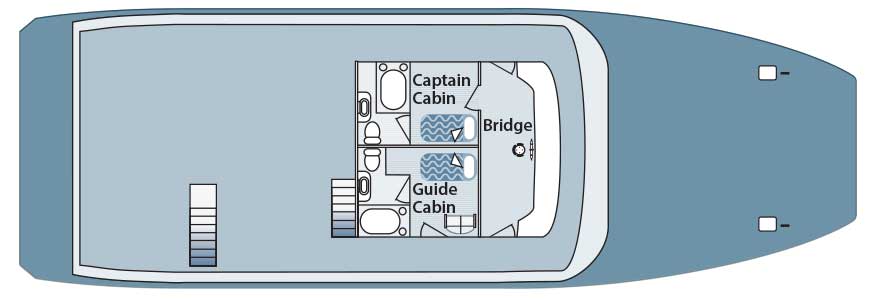M/C Anahi Catamaran Yacht

M/C Anahi Catamaran Yacht
The accommodation for sixteen voyagers is distributed amongst six 14m2 twin cabins on the main deck (2 transformable to double bed), and two 25m2 suite cabins on the upper deck. Every cabin includes large windows - portrait type - looking to the ocean, beautiful wooden floor and cozy private facilities with hot/cold water shower, besides to a locker, closet and air conditioning.
Additionally, on the main deck, the yacht offers ample resting areas, library, TV-DVD room, comfortable dining room and lounge. On the upper deck, the yacht features a charming bar and an excellent area for relaxation, together with a Jacuzzi for six people. On top of the bar area we find the ample sundeck with resting chairs for eight people.
WELCOME TO QUITO, ECUADOR
Arrive in Quito where you will be met by your guide after passing the customs area and then transfer to your boutique hotel Le Parc. Two nights in double accommodation, buffet breakfast and local taxes included.
QUITO GASTRONOMIC ADVENTURE
- Your guide will meet you today at 09:30 am and will take you to visit the « Mercado Central » where you stop at various affiliated stations, the Chef explains about the products and culinary traditions. You buy together the ingredients for the cooking class. You can take pictures, taste some endemic fruits and make your own purchases if desired. You return to Altamira (walking or by transport).
- The cooking class begins: we offer you a chef's hat and an apron for preparing the 3 dishes you will cook; which they are typical Ecuadorian recipes: a « Locro Quiteño », a « Encocado » and a Chocolate Soup. These foods have been chosen specifically because the ingredients used can be found worldwide, so you will have the chance to cook these recipes in your own country. You are invited to participate and to become a Chef: you have the possibility to manipulate food, peel, cut, season, mix, beat... During the class, the Chef is accompanying and guiding you, he gives explanations and details about the history of each dish and its origin.
- After elaborating the 3 courses, you have the pleasure to taste what you own prepared with the Chef in and unique place:
in the “patio” of a Colonial House. The class ends with a round of applause for all participants.
- After your nice lunch made by your own the tour continues exploring the city and you go in direction to the chocolate museum, in this place you can learn about the cacao bean and the all process to make the famous Ecuadorian chocolate. Of course, here you have access to the historical information and how important it is for our national economy.
- Once we finish this visit we will continue visiting the different plazas and seeing people and traditional works.
- Once you finish the visit we will continue to the traditional neighborhood of La Ronda, here we can have a clear idea of how the village looked back to the XVIII century.
- At the end of the afternoon, we will go to visit the monastery of Santo Domingo and admire the art of the famous school of art of Quito from the Spanish colony period. In the afternoon we will return to the hotel.
AM: Flight to Galapagos from Quito Airport
The flight from Quito to the Galapagos is approximately 2 ½ hours on a Boeing 727. Upon arrival at Baltra travelers pass through an airport inspection point to insure that no foreign plants or animals are introduced to the islands and to pay the park entrance fee of $100 (unless prepaid), and $10 for the INGALA card which is an identity card that you need . Guides will meet you, collect your luggage, and escort you on the short bus ride to the harbor. Motorized rafts, called ‘Pangas’ will transport you to the M/C ANAHI and our crew will welcome you onboard. After departure and lunch, the first island visit is made.
PM: HIGHLANDS OF SANTA CRUZ
Santa Cruz Highlands: Journeying across Santa Cruz into the highlands visitors are delighted by the island's variety of life and geology. Beginning at the coast and traveling across Santa Cruz the road departs from Puerto Ayora climbing through the agricultural lands and into the mist covered forests. Santa Cruz possesses all of the various life zones present in the archipelago. As you travel through these zones birders are enchanted. Whether it's the bright red feathers of a vermillion flycatcher or one of Darwin's Finch almost every bird present in the islands can be found here.
Santa Cruz offers excellent opportunities for viewing wild Galapagos Tortoises. Tracking tortoises is not the only exciting activity to be found in the highlands. There are also plenty of lava tubes, sinkholes and craters to explore. Theses eerie formations offer a fascinating hike into the belly of the island to view its volcanic make-up.
AM: White Tipped Reef Shark Canal
A delightful place reached by a nice zodiac ride. "Tintoreras” are small islands in front of Puerto Villamil coast.
There is Heron lava on the lookout on mangrove branch, and Galapagos penguin and sea lion often pop out on shore. White-tipped reef sharks are fairly common in the archipelago. Their name in Spanish is Tintoreras, thus the name of this site as they are always found here resting in the shallow waters.
Wall of Tears: The Wall of Tears is a historic site in Isabela. Between 1946 and 1959 Isabela was a penal colony, where prisoners build a wall with huge blocks of lava as punishment. The wall is 100 meters long and 7 meters high. Due to the arduous labor and harsh conditions in which the prisoners lived, this site is known as the wall of tears.
A set of stairs provides a bird's eye view of the wall and the surrounding landscape. You can still see the cement foundations of the USA base dating back to the Second World War.
PM: Sierra Negra Volcano.
Isabela Island is the largest and one of the youngest islands in the Galapagos archipelago. We land in Puerto Villamil, which has the second smallest populated island in Galapagos with approximately 3,000 habitants. We head up to the highlands from Puerto Villamil to Sierra Negra slope, and later we will do some hiking on uneven terrain until we arrive to the Sierra Negra volcano rim. Sierra Negra is the second widest crater in the world. From this viewpoint, you have fantastic sights to the 6 x 5 mile wide crater, the rest of the volcanoes, and Perry Isthmus, a 12 Km wide lava field. From here we can hike to Chico Volcano to watch the striking lava formations, examples of the geological occurrences that have created the Galapagos Islands.
AM: Punta Moreno
Punta Moreno is located on the north coast of Isabela Island between the volcano Sierra Negra and Cerro Azul volcano. The trail runs along a lava flow Pahoehoe (solidified lava in the form of corrugated or an accordion) into a complex of coastal lagoons, its main attraction are several species of birds which can be found around this lakes and mangroves
PM: Elizabeth Bay
This is a marine visitor site, the excursion is carried out in a zodiac and so there is no landing point. Your zodiac ride starts with a visit to the Marielas islets where there is the largest and most important penguin colony in the Galapagos Islands. The excursion continues into the cove that is surrounded by red mangroves where you can admire their red roots and green leafs. It is here that you are able to observe sea turtles, flightless cormorants, spotted eagle rays, golden rays, brown pelicans, and sea lions. Frequently visitors have been able to see Galapagos hawks soaring overhead while schools of Pompano and Dorado fish swim below
AM: Urbina Bay
South from Tagus Cove and still on the West coast is Urbina Bay. It is an easy wet landing on a gentle sloping beach. This area is very interesting in that it is a perfect example of the geological activity of the islands. The waters of the bay are a good place to see turtles and rays and ashore is a short trail leading to a coral reef, which is evidence of an uplift from the sea which occurred in 1954. From here it is easy to reach the Alcedo and Darwin volcanoes. You can see large colored land iguanas here and the possibility of seeing giant Galapagos turtles, flightless cormorants, blue-footed boobies, Galapagos penguins, pelicans, and marine iguanas is excellent.
PM: Tagus Cove
Tagus Cove, a tour along the cliffs in a zodiac will give the visitors a good chance to see the Galapagos penguin, the flightless cormorant and other sea birds. From the landing dock it is about a 30 minute hike along the trail up to the top of the cliff from where you can view Darwin Lake, an uplifted ultra saline lake saltier than the sea. You can also see several volcanoes from this location. Look carefully at the graffiti on the surrounding cliffs of the cove, it has been written by pirates, whalers and buccaneers in past centuries.
AM: Espinoza Point
Fernandina is the third largest island in the archipelago and has a single visitor site: Punta Espinoza located at the northeastern tip of the island. Just across Tagus Cove, is a visitor site where some of the unique species of Galapagos can be seen. Marine iguanas conglomerate in larger groups than in any other island. They bask around in the sand, swim near the shore, and some time block the way at the landing dock. Among the unique species found here, is the flightless cormorant. A bird that do to the lack of predators had to adjust their way of survival and perfectionate their skills of finding food in the ocean. Their wings, tails, and feet progressively adapted for swimming. To see these birds, is to witness evolution happening right in front of you.
PM: Vicente Roca Point
Located at the ‘mouth’ of the head of the sea horse, which forms the northern part of the Galapagos Islands, is Punta Vicente Roca. Here the remnants of an ancient volcano form two turquoise coves with a bay well protected from the ocean swells.
The spot is a popular anchorage from which to take panga rides along the cliff that are the remains of the volcano or explore a partially sunken cave at the water’s edge. Masked and blue-footed boobies sit perched along the point and the sheer cliffs, while flightless cormorants inhabit the shoreline.
The upwelling of coldwater currents in this part of the Galapagos, give rise to an abundance of marine life which, in combination with the protection of the coves, make Punta Vicente Roca one of the archipelago’s sough after dive spots.
One cove is only accessible from the sea by way of an underwater passage. The passage opens to calm waters of the hidden cove where sea lions like to laze on the beach having traveled along the underwater route. The entire area of Punta Vicente Roca lies on the flank of 2,600 foot Volcano Ecuador. This is the Galapagos Island’s sixth largest volcano.
AM: Puerto Egas.
The excursion to Puerto Egas with its black sand beaches leads to one of the more rewarding visits of the Galapagos. The island was the site of a small salt mining industry in the 1960s, one of several unsuccessful attempts to commercialize the Galapagos. A hike inland to the salt crater is an excellent opportunity to see land birds such as finches, doves, and hawks. A walk along the rugged shoreline, especially at low tide, will allow us to observe many marine species as Iguanas bask on the rocks and sea lions laze in the tide pools. At the end of the trail there is a series of grottoes or sea caves where fur seals and night herons are regularly found resting on the shady ledges. For many, this is the only opportunity to see the Galapagos fur seal, once thought to be on the verge of extinction.
PM: Rabida
Rabida Island is unique because the red color of the rocks and sand. The volcanic material in this island is very porous and external factors as rain, salt water, and sea breeze have acted as an oxidizing agent.
A short walk along a trail lead you to a coastal lagoon behind the beach which permits you to observe the land birds such as finches, doves, yellow warblers, and mocking birds. At the lagoon there is a colony of flamingos.
AM: Chinese hat
This is a small islet (1 sq km) located just off the southeastern tip of Santiago Island. It is a recent volcanic cone, shaped like a Chinese hat when seen from north side. On the west you can see lava formations, formed under the sea and raised upward, this is why coral heads are found on the lava. This is an excellent visit for interpretation of geological features such as lava tubes and lava flows. The landscape is covered by sea lions colonies, marine iguanas, and Galapagos penguins.
PM: Bartolome Island
A small barren island that is located across from Sullivan Bay off James Island, Bartolome has two main visitors’ sites. The first site offers the possibility to climb to the summit of the island, from where visitors can observe a variety of volcanic formations including lava bombs, spatter and cinder cones, lava flows, and lava tubes. The moon like landscape provides one of the most scenic panoramas in the archipelago. At the second site, visitors have the chance to relax on a beautiful beach, which offers great snorkelling opportunities. Multi –colored fish and occasionally penguins and sea turtles have been seen at the base of the tall pinnacle rock, which dominates Bartolommeo’s landscape. A short walk across to Bartholomew’s second beach, which swimming is strictly prohibited visitors can see white-tipped reef sharks, at a safe distance swimming along the shoreline.
AM: North Seymour
Is an uplifted (as opposed to volcanic) island and so is generally flat and strewn with boulders. There are good nesting sites here for a large population of magnificent frigate birds. Blue-footed boobies perform their courtship dance in the more open areas and swallow-tailed gulls perch on the cliff edges. Despite the tremendous surf that can pound the outer shore, sea lions haul out onto the beach and can be found bodysurfing. After the morning excursion you will be taken to the airport for your flight to the mainland.
GROSS RATES |
4D/3N | 5D/4N | 8D/7N |
|---|---|---|---|
| Standard Cabin | $2,260 |
$2,785 |
$4,445 |
| Suite Cabin | $2,365 |
$2,950 |
$4,710 |
| Charter | $34,125 |
$42,660 |
$68,250 |
GROSS RATES |
11D/10N | 12D/11N | 15D/14N |
|---|---|---|---|
| Standard Cabin | $6,115 |
$6,665 |
$8,335 |
| Suite Cabin | $6,480 |
$7,070 |
$8,835 |
| Charter | $93,845 |
$102,375 |
$127,970 |
Main Deck

Upper Deck

Master Deck

Specifications
| Type: |
|
| Category: |
|
| Year: |
|
| Lenght: |
|
| Beam: |
|
| Capacity: |
|
| Main Engines: |
|
| Electric System: |
|
| Speed: |
|
| Water Capacity: |
|
| Diesel Capacity: |
|
| Material Construction: |
|
| Interiors: |
|
| Exterior: |
|
| Crew: |
|
| Navigation & Safety Equipment: |
|
| Accommodation: |
|
Inclusions:
Exclusions:
Important Observations
Contact Us
Sponsor Spotlight
M/Y Stella Maris
Galapagos luxury yacht charters, offering upscale cruises in a unique wildlife destination.
Exclusive Galapagos Cruises
Exclusive Galapagos Cruises
Machu Picchu Inc


